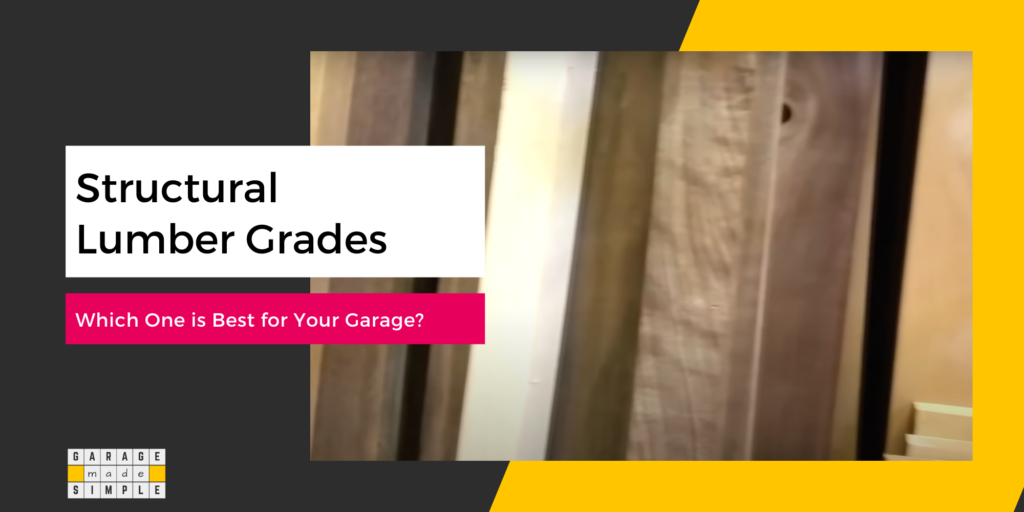Structural Lumber Grades: Which One is the Best for Your Garage?
garagemadesimple.com is a participant in the Amazon Services LLC Associates Program, an affiliate advertising program designed to provide a means for sites to earn advertising fees by advertising and linking to Amazon.com . The website is also an affiliate of a few other brands.
What Grade Lumber Is Best for Framing a Garage?
Is this your first time building a garage? It can be a bit overwhelming! Take lumber, for example. There are several structural lumber grades. Choosing the right one is crucial for ensuring structural integrity and durability of your garage So, what grade of lumber is used for framing a garage?
Use only #1 Grade Structural Lumber for framing the load bearing walls & other structures of your garage. It should be straight, smooth and almost free of knots. You may use #2 Grade Structural Lumber for non load bearing walls & structures. It may have a few knots and other imperfections, but should be straight and free of serious defects.
Structural lumber grades are determined by the quality and appearance of the wood, as well as its intended use. Specifically
- Structural lumber grades indicate the strength and structural integrity of the lumber.
- Different grades of lumber are suitable for different types of construction.
- Using the proper grade for the framing of a garage is crucial for ensuring the safety and stability of the structure.
- Lumber is graded based on factors such as the number and size of knots, the presence of defects, and the overall strength of the wood.

In this article, I explain the different grades of lumber available and how to select the best option for your garage frame.
NOTE: Grading rules and nomenclature may be different for different countries and regions.
What Are the Different Grades of Structural Lumber?
There are many different grades of structural lumber. The actual differences between the grades can sometimes be a bit confusing and difficult to detect.
The four most well known grades are:
Select Structural:
Select Structural is the highest grade of structural lumber and is mostly used for heavy load-bearing applications such as in construction of bridges and large buildings. Select structural grade lumber has fewer defects & knots and can be used for outdoor applications such as exposed beams.
The knots must be smaller than a specified size. Moreover, the knots must be tight and fairly evenly spaced so that the lumber does not hve any weak spots.
#1 Grade Lumber
#1 Grade Lumber is extremely high grade but just a shade lower than Select Structural grade. This grade is ideal for load-bearing applications such as beams, headers and rim joists.
#1 Grade Lumber has very few knots, defects and other blemishes. It therefore has a fairly uniform appearance.
#2 Grade Lumber
#2 Grade Lumber is a lower quality lumber than #1 Grade Lumber. It has more knots, checks or other defects. #2 Grade Lumber is best used for framing of non-load bearing walls, sheathing, and rough carpentry.
#2 Grade Lumber has an inferior appearance and is therefore not a good choice for finished carpentry, such as trim and cabinetry.
#3 Grade Lumber
#3 Grade Lumber is the most inferior grade of structural lumber. The number of knots & defects are permitted to be fairly high.
In spite of this #3 Grade Lumber can still be used for light load-bearing applications in non critical buildings in gardens, farms, etc. such as sheds, fences or walkways.
Other common uses include making pallets, crates, etc.
Are There Any Other Lumber Grades?
In addition to the above mentioned grades the following terms are also used to describe certain structural lumber grades:
BTR (Better) Grade
BTR (Better) grade lumber is also considered to be of good quality, but it may have a few more knots and defects than #1 grade lumber. It is often used for heavy load-bearing applications such as beams, headers and rim joists.
Standard Grade
Standard grade lumber is of higher quality than construction grade lumber, as it has fewer knots, straighter grain and more uniform appearance.
Standard grade lumber is often used for framing, flooring and structural elements where both strength & looks are important. It is more expensive than construction grade lumber and is typically made from softwood species such as pine, spruce, and fir.
Construction Grade
Construction grade lumber is also used for framing, sheathing and other structural elements. It is not as visually appealing as higher grade lumber, but is cheaper and functionally adequate for construction projects.
Stud Grade
Stud grade lumber is usually 2×4 or 2×6 in size and is used for framing walls, floors, and ceilings. It is also used as headers, cripples or other framing elements.
Stud grade lumber is cost-effective and versatile. Generally, 2×4 studs or 2×6 studs are made from softwood trees such as pine, spruce and fir.
Utility Grade
Utility grade lumber is the lowest quality and cheapest lumber available. The quality of utility grade is lower than that of standard and construction grade lumber.
Utility grade lumber has more knots, and irregular grain patterns. It may also have other defects such as holes or missing pieces. It is often used for non-structural purposes such as sheathing, rough framing or temporary structures.
Do Structural Lumber Grades Depend on the Type of Wood?
Yes, structural lumber grades depend on the type of wood. Different types of wood have different strength characteristics, and so they are graded accordingly.
SPF, SYP and DF are commonly used as structural lumber. However they have their own grading rules set by the American Lumber Standards Committee (ALSC).
Thank you very much for reading the post. I do hope you found it informative and useful.






